The Indiana Bat Monitoring/Tracking Project
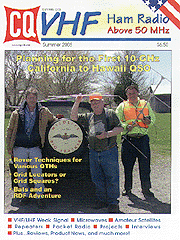 Note: The Indiana Bat monitoring/tracking project concluded in 2005. This page tells the history. It was also the subject of my Homing In column in CQ-VHF Magazine for Summer 2005, titled "The Watertown Sodalis Squad -- An RDF Adventure."
Note: The Indiana Bat monitoring/tracking project concluded in 2005. This page tells the history. It was also the subject of my Homing In column in CQ-VHF Magazine for Summer 2005, titled "The Watertown Sodalis Squad -- An RDF Adventure."
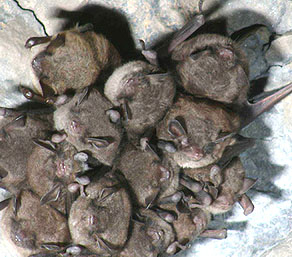 On 20 January 2005, I received this request from Carl Herzog AB2SI of the New York State Department of Environmental Conservation:
On 20 January 2005, I received this request from Carl Herzog AB2SI of the New York State Department of Environmental Conservation:
"Our agency is currently preparing for two radio tracking projects that will take place from mid-April to early May 2005. We will be attaching transmitters to Indiana bats (Myotis Sodalis), an endangered species, as they leave their winter caves and we'll attempt to find them in their summer habitat out on the landscape. Both projects will be happening simultaneously and we are looking for volunteers (with or without equipment) to help with radio tracking.
"One cave is located in the Kingston, NY area. Previous experience suggests that some of these bats will fly to Orange and Dutchess Counties in NY. Others might fly anywhere within 300 miles, but most likely they will be found in lower NY, western CT, northern NJ, or eastern PA. The bats do not limit themselves to wilderness, but are often found in farm country or even suburban areas.
"The second cave site is in western NY near Watertown. We have no idea where these bats will go but, again, we do not expect them to travel more than 300 miles and probably less than 50 miles. This radius includes southern Ontario and Quebec - bats know nothing about national borders.
"Transmitters will be operating between 150 and 151 MHz. If you think of a single Morse 'dit' repeated every second or so, you'll have a good idea of what they sound like. Generally speaking, you'll need a SSB/CW capable receiver to hear anything. For folks who live in the right areas and are willing to devote a bit of time to this project, we might be able to provide receivers and/or antennas."
Background
Out of 45 bat species in the USA, about one third are either threatened or endangered. There are millions of bats in New York state, but the number of Indiana Bats is only between 30,000 and 35,000. Myotis sodalis is the only federally-listed endangered bat in the state. The worldwide population for this species has declined drastically since the 1960's, dropping from about 800,000 down to about 300,000.
According to AB2SI, "Most other mammal species have been researched to a very significant extent, but bat biology so difficult to study that there are basic questions we don't yet know the answers to. It's only been in recent years that we've been able to get transmitters small enough to put on them so we can use radio tracking as a tool."
In other parts of the country, bats spend time underground year-round. In New York, the cave bats only spend the winter there. There are only nine caves and mines that in the entire state where Indiana Bats do that at present. Research indicates that this is because the bats are limited in the temperature range that they can tolerate during hibernation -- most caves are too hot or too cold.
Sodalis must be relatively undisturbed throughout the winter. If cave explorers were to wake them, even for a short time, they would use up their stored food resources and perhaps not last through the winter. This is not an issue in New York, because the sites are gated or on private property with no access to the public. That may explain why the New York population loss is not as great as elsewhere.
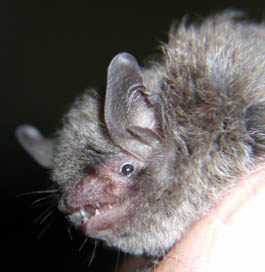 In my previous experiences with migratory bird studies, it was good to have a large number of participating hams scattered over a very wide area. Just being able to hear and log the tags was sufficient to help the researchers. But these bats were not flying cross-continent and exact locations would be important. What Carl needed was a team of intrepid trackers who were willing to scour the countryside. I posted Carl's request (above) on this Web site and hyped it on Amateur Radio Newsline and other ham news outlets. I was disappointed when my in-box didn't get many replies, but I discovered later that Carl had gotten all the help he needed, both from stay-at-home hams and those who would go out in the wild.
In my previous experiences with migratory bird studies, it was good to have a large number of participating hams scattered over a very wide area. Just being able to hear and log the tags was sufficient to help the researchers. But these bats were not flying cross-continent and exact locations would be important. What Carl needed was a team of intrepid trackers who were willing to scour the countryside. I posted Carl's request (above) on this Web site and hyped it on Amateur Radio Newsline and other ham news outlets. I was disappointed when my in-box didn't get many replies, but I discovered later that Carl had gotten all the help he needed, both from stay-at-home hams and those who would go out in the wild.
"We ended up with a total of five new field workers," AB2SI told me. "Three of them were on the project full time. They heard about it through your site and called my office to volunteer. When I found out that all of them knew radio propagation and had done a significant amount of RDF, I thought it would be a good match. We had some extra funding and we were able to hire them for the study."
Since Carl's office in Albany is a considerable distance from Watertown, it was difficult for the regular staff to work at the site for long periods. Having volunteers doing the ground work was a big plus. In addition to the on-site volunteers, I found out that many volunteers were listingin at home.
Remainder of the project log
More information from Carl Herzog AB2SI received March 25, 2005: "Everything is proceeding according to plan. We don't expect the bats to
begin to emerge from their winter quarters until approximately 15 April
and we'll wait until they do so to attach the transmitters. The exact
date will depend on the weather, more specifically temperature. The
first warm pulse in the middle of April is usually what triggers things
into action. Once that happens, things proceed at a fast pace. The first phase will
involve 40 animals in the Watertown, NY area. All will be released in a
single night. We will have a radio-equipped airplane circling the
release site that night to give us an idea which direction they take.
Our experience is that they orient themselves pretty quickly and seem to
know where they are headed. It's not really feasible to follow them very
far from the air, though. We really have little idea where these
animals will go. We'll use 6 different frequencies to help us sort out
some individual behavior.
"A few days later we will do the same thing for 20 more animals in the
Kingston, NY area. Last year, bats from this site were located within
about 30 miles of the release site, although we never found about half
of them. Other folks who have tracked this species have reported
distances traveled upwards of 200 miles.
"In both cases we will utilize a combination of air and ground-based
searches in the succeeding days, hopefully guided by the information
gained on the release night regarding the bats' initial direction of
travel. The typical pattern is that they get where they are going in a
day or two and then females begin to group together into maternity
colonies of 50-200 individuals. They roost in trees and move from one
tree to another every couple of days or so. Lots of ground follow-up is
required (fun work for volunteers, that) as we keep track of the bats'
activity. Among other things, we are interested in describing the kinds
of trees they use, what types of places these tree are found in, etc. We expect the transmitter batteries to last
about 3 weeks. The bats are just too small to carry any more than that.
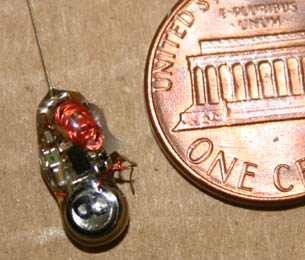 UPDATE from Carl Herzog AB2SI received April 11, 2005:
UPDATE from Carl Herzog AB2SI received April 11, 2005:
"In New York we have settled on a total of 6 different frequencies:
150.085 MHz
150.120 MHz
150.200 MHz
150.350 MHz
150.500 MHz
150.725 MHz
"We will have approximately 10 transmitters on each frequency during
this year's project. Each transmitter exhibits one of three pulse
rates: 30, 45 or 60 pulses per minute. The pulse rate will vary a bit
with temperature but these three rates are sufficiently spaced we should
be able to distinguish between them in the field. If you happen to hear
what sounds like one of these transmitters, please record the pulse rate
in pulses per minute as well as the transmit frequency.
"These transmitters are crystal controlled, but because of their
minimalist design (no shielding, unregulated power supply, etc) they
don't exhibit the frequency stability and clean CW note that crystal
control usually implies. This means, unfortunately, that you can't
count on finding the transmitter exactly on frequency. If you use a
typical CW filter (500 Hz bandwidth) to boost your sensitivity,
you might miss the signal unless you tune above and below the stated
frequency. This is one of the reasons why professional wildlife
receivers typically have a 2 kHz IF bandwidth, more like that used for
SSB than CW.
"Furthermore, tolerances on the crystals means there is some deviation
from the stated frequency. Most start out pretty accurate (within 1 kHz
of the stated frequency at room temperature) but between the crystal
variations, temperature drift, body-capacitance effects as the bats cram
together in a tiny space, and calibration accuracy of the receiver's
frequency indication, you'll need to allow for at least 2 kHz of error
from the stated frequency. If your radio's dial accuracy is unknown,
then even more allowance might be in order.
"One of our counterparts in Pennsylvania is also tracking
Indiana bats this year from a site in western PA. He believes his bats
fly east toward Eastern PA and New Jersey. All of his animals are on
172.1700 MHz. Any contacts on this frequency can be sent to me and
I'll relay them as appropriate.
"Our experience is that these bats fly from their winter cave almost
directly to where they spend the summer, arriving within a day or two
after we let them go. They roost in trees during day, 8-30 or more feet above the ground.
They will typically stick to one tree for a couple of days and then
move to a different one in the same general area (less than a mile away,
and often quite a bit less). This process of jumping back and forth
between several trees will continue for the duration of our study. All
of this means that if you don't detect them in one area during the
first week then you are likely never going to. It wouldn't hurt to
keep monitoring from that site, of course, but moving to a different
location would be a potentially more productive use of your time.
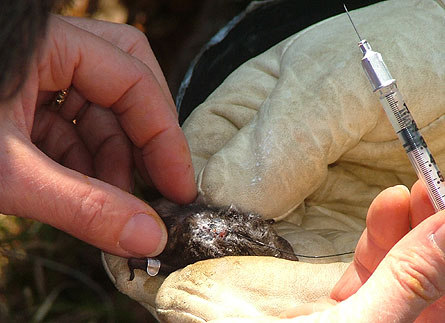 "They fly at dusk to feed on insects every night that it's not too
cold (50 F is about their lower limit) and your detection distance can
increase dramatically at this time, although there will be fading due to
multipath as they fly about. On a warm night they might be out any time
before dawn, although at this time of year it tends to get pretty cold
after midnight.
"They fly at dusk to feed on insects every night that it's not too
cold (50 F is about their lower limit) and your detection distance can
increase dramatically at this time, although there will be fading due to
multipath as they fly about. On a warm night they might be out any time
before dawn, although at this time of year it tends to get pretty cold
after midnight.
"Vertical RDF antenna polarization seems to work best when they are in the trees
(during daylight), although not always. Horizontal polarization nearly
always works best when the bats are flying, although they do roost
periodically during the night so you can't count on that either.
It's best to try both. If you have to choose, go with vertical
during the day and horizontal at night.
"We use whip antennas when driving around and yagis for everything else.
Even our airplanes have yagis on them. A three or four-element beam
will at least double your effective detection distance over a whip but,
of course, you have to aim it - fine for monitoring from a fixed site
but if you are on the road you have to stop periodically to scan the
antenna. I want a truck with a couple of stacked, long yagis on a
rotator that can be operated from the driver's seat but, as someone
once said, you can't always get what you want.
"Several folks have asked if FM gear can be used. The short answer is
no, it's probably not worth your time. The transmitters do chirp a bit
so you can often pick up something with an FM detector but the effective
range is going to be greatly reduced. Pulse width is not well controlled but is something like a single morse
'dit.' There can be significant chirp
which tends to spread the RF energy out a bit. Most hams wouldn't be
happy if their CW signals sounded like the typical bat transmitter.
"Transmit signal strength varies a bit but to put things in perspective,
we often pick up the signal from a mile over typical ground and 3-4
miles line of sight using a pretty sensitive receiver with a 2 kHz IF
bandwidth and a 2-3 element yagi. This isn't great but it's what we have
to work with. Many wildlife transmitters used for bears and other larger
animals (even birds) are much more powerful.
"If you have mobile capability and attempt to pinpoint the location of
any signals please respect private property rights. Don't traverse
private property without the landowner's specific permission. If in
doubt, err on the side of caution and refer all the relevant details to
me."
UPDATE from Carl Herzog AB2SI received April 18, 2005: "We sucessfully tagged 32 Indiana bats at the Watertown site last night (Sunday).
The initial tracking from the air indicated that most flew toward the
south but a substantial contingent went north as well, so Canada is
definitely a possibile destination - if so it would be the first
recorded instance of an Indiana bat north of the US border. Lake
Ontario to the west is presumably an uncrossable barrier for them and we
didn't see much indication that any flew east into the higher
elevations. So far we have located several bats in the local area, less than 15 miles from
the release site. Whether they will stay local or fly on farther in
coming nights remains to be seen. Further updates will follow as time
allows."
UPDATE from Carl Herzog AB2SI received April 20, 2005: "The Watertown phase of the project is well underway. Many of the bats
have been located in the area surrounding Watertown (within 15 miles radius).
Ground followup on these animals will continue for the next 2-3 weeks.
Others remain unaccounted for and searching far and wide may be
necessary. At last report, our counterparts in Pennsylvania have
sucessfully tracked at least two animals well over 100 miles from their
release site, so long distance migration is clearly a possibility. The Kingston phase begins tomorrow (Thursday) with the scheduled release of
20 more animals. As mentioned previously, when we did this there last
year all of the animals we found were in either Orange or Ulster
Counties, but almost half escaped detection and could have flown to
Connecticut, New Jersey, Pennsylvania or elsewhere. We will chase these
animals for approximately the next 3 weeks as well. There will be numerous opportunities for ground followup over the next
few weeks so if you are reasonably local to either site, let me know and
we can probably give you an entertaining opportunity to apply your
fox-hunting skills. If you lack equipment we usually have receivers
and/or antennas available for loan. Reports generated by those
monitoring from home will, of course, be greatly appreciated as well."
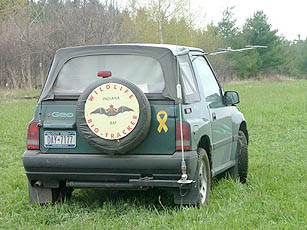 UPDATE from Carl Herzog AB2SI received April 24, 2005: "Things have been hectic so it's been difficult to post an update until
today (Sunday). We tagged and released 18 bats from the Kingston site on
Thursday night. Initial indications were similar to last year in that
the bats tended to fly south and southeast, with one lone individual
bucking the trend by going North.
Air monitoring the following day located 6 animals in Orange and Ulster
Counties, but 2/3 of the animals escaped detection. Some could easily be
in Connecticut, New Jersey or Eastyern Pennsylvania. Rain moved into the
area late in the day curtailing our flights and yesterday was a complete
washout for the planes, although ground crews attempted to get precise
locations on those found from the air the day before. We may be able to
get back in the air later today. A ham in Ulster county reported hearing one of our bats from his home
and this was a new one for us. We failed to precisely locate it
yesterday and will try again today. Other hams have figured prominently
in our ground crews and have proven to be extremely helpful.
One of the most interesting reports from the radio amateurs on this
project continues to be that received from Harry, KS2D in Jamestown NY.
He reports a signal that is on the 150.725 frequency which sounds like
one of ours. If it turns out to be legitimate it will represent the
farthest travel distance over which an Indiana bat has ever been tracked
by radio. Harry and his cohorts are trying to pin down the location. It
is possible, however, for realistic sounding signals to be generated by
household electronics. Police scanners, for example, have fooled us a
couple of times in the past."
UPDATE from Carl Herzog AB2SI received April 24, 2005: "Things have been hectic so it's been difficult to post an update until
today (Sunday). We tagged and released 18 bats from the Kingston site on
Thursday night. Initial indications were similar to last year in that
the bats tended to fly south and southeast, with one lone individual
bucking the trend by going North.
Air monitoring the following day located 6 animals in Orange and Ulster
Counties, but 2/3 of the animals escaped detection. Some could easily be
in Connecticut, New Jersey or Eastyern Pennsylvania. Rain moved into the
area late in the day curtailing our flights and yesterday was a complete
washout for the planes, although ground crews attempted to get precise
locations on those found from the air the day before. We may be able to
get back in the air later today. A ham in Ulster county reported hearing one of our bats from his home
and this was a new one for us. We failed to precisely locate it
yesterday and will try again today. Other hams have figured prominently
in our ground crews and have proven to be extremely helpful.
One of the most interesting reports from the radio amateurs on this
project continues to be that received from Harry, KS2D in Jamestown NY.
He reports a signal that is on the 150.725 frequency which sounds like
one of ours. If it turns out to be legitimate it will represent the
farthest travel distance over which an Indiana bat has ever been tracked
by radio. Harry and his cohorts are trying to pin down the location. It
is possible, however, for realistic sounding signals to be generated by
household electronics. Police scanners, for example, have fooled us a
couple of times in the past."
UPDATE from Pat Browns WN8Z received May 7, 2005: "We
are still tracking and starting to enter the gray period where tiny
batteries are just starting to fail. In the Watertown area we have
started experiencing frequency drift. So if you are one of the hams with
an ear to the radio, use the center frequencies and tune up
and down from there. I've seen as much as a 900 Hz drift (most are
drifting low). In the field we are finding that horizontal
polarization seems to work best the majority of the time -- that was a
surprise to all of us. We expect to lose the 60 pulse-per-minute
transmitters first, as they are transmitting more often than the
45 ppm and 30 ppm transmitters. 14 hour days are the norm for us
trackers. So rest assured anyone that is putting time
in monitoring from home or elsewhere that we really do appreciate
your reports!"
UPDATE from Pat Browns WN8Z received May 22, 2005: "Wow - what an adventure! As of Thursday May 19th there was only one transmitter bat still
sending out his signal from the Watertown, NY release - it is a 45
ppm signal and was still being heard a good distance away. Our
tracking team has secured from active tracking and we will be
checking on this last holdout as time permits. To all the amateurs and interested parties who have been following
this project here, and especially to those who spent time listening
for the tag signals, Your
time and efforts were not in vain. Every day I talked with
interested amateurs who devoted time listening from as far as 70
miles away and to others who were right in the Watertown, NY
vicinity and every minute each of you contributed to this project
was worth 60 or more to us in the field. Negative data is valid
data. By letting us know that you heard no signals allowed us to
concentrate our time in other areas. Thanks to each and every one of
you."
UPDATE from Carl Herzog AB2SI received May 25, 2005: "Pat WN8Z posted a nice update on the Watertown portion of our project a few days ago – thanks, Pat – and it is appropriate for me to do likewise. All of our transmitters from both the Watertown and Kingston sites are now dead. We had very good results overall, finding 16 of 18 bats from Kingston and approximately 26 out of 32 at Watertown. All of the bats that we found were within 40 miles of the release site and, yes, we did encounter a lot of false alarms triggered by spurious emissions from scanners. (As it turned out, almost all were on 150.725 MHz, which is a lesson for us in future studies: Do a better job of planning the frequency choices!) We didn’t get any animals in Canada, but one was close, only a few miles from the border. Nor did any of our bats venture into other adjacent states but, of course, we can’t be sure about those we didn’t find. As Pat hinted, the results are going to prove extremely valuable in our efforts to ensure the continued existence of this endangered species. Without going into details, there are some very immediate issues that these data will help us with. Echoing his comments, I’d like to also express my thanks to everyone who helped out on this project and especially to Joe KØOV for maintaining his web site and e-mail list. Amateurs contributed significantly to this project – frankly, we couldn’t have done it without you folks – and you can expect that others in the wildlife biology community will be looking to draw on your collective knowledge and experience in the future."
In the photos above, top to bottom:
- Small cluster of Indiana Bats on a cave ceiling (Courtesy NY State Department of Environmental Conservation)
- Indiana Bat profile (NYSDEC)
- Bat radio tag (NYSDEC)
- Attaching a bat tag (Courtesy Pat Browns WN8Z)
- Pat Brown's Geo outfitted for bat tracking (WN8Z)
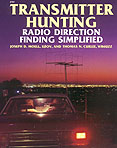 Go to Frequently Asked Questions about Wildlife Monitoring, including equipment suggestions
Go to Frequently Asked Questions about Wildlife Monitoring, including equipment suggestions
Go to Was That Really A Wildlife Tag?
 Back to the Volunteer Wildlife Tracking page
Back to the Volunteer Wildlife Tracking page
Back to the Homing In home page
This page updated 20 May 2006
 Note: The Indiana Bat monitoring/tracking project concluded in 2005. This page tells the history. It was also the subject of my Homing In column in CQ-VHF Magazine for Summer 2005, titled "The Watertown Sodalis Squad -- An RDF Adventure."
Note: The Indiana Bat monitoring/tracking project concluded in 2005. This page tells the history. It was also the subject of my Homing In column in CQ-VHF Magazine for Summer 2005, titled "The Watertown Sodalis Squad -- An RDF Adventure."
 On 20 January 2005, I received this request from Carl Herzog AB2SI of the New York State Department of Environmental Conservation:
On 20 January 2005, I received this request from Carl Herzog AB2SI of the New York State Department of Environmental Conservation:
 In my previous experiences with migratory bird studies, it was good to have a large number of participating hams scattered over a very wide area. Just being able to hear and log the tags was sufficient to help the researchers. But these bats were not flying cross-continent and exact locations would be important. What Carl needed was a team of intrepid trackers who were willing to scour the countryside. I posted Carl's request (above) on this Web site and hyped it on Amateur Radio Newsline and other ham news outlets. I was disappointed when my in-box didn't get many replies, but I discovered later that Carl had gotten all the help he needed, both from stay-at-home hams and those who would go out in the wild.
In my previous experiences with migratory bird studies, it was good to have a large number of participating hams scattered over a very wide area. Just being able to hear and log the tags was sufficient to help the researchers. But these bats were not flying cross-continent and exact locations would be important. What Carl needed was a team of intrepid trackers who were willing to scour the countryside. I posted Carl's request (above) on this Web site and hyped it on Amateur Radio Newsline and other ham news outlets. I was disappointed when my in-box didn't get many replies, but I discovered later that Carl had gotten all the help he needed, both from stay-at-home hams and those who would go out in the wild.
 UPDATE from Carl Herzog AB2SI received April 11, 2005:
UPDATE from Carl Herzog AB2SI received April 11, 2005:  "They fly at dusk to feed on insects every night that it's not too
cold (50 F is about their lower limit) and your detection distance can
increase dramatically at this time, although there will be fading due to
multipath as they fly about. On a warm night they might be out any time
before dawn, although at this time of year it tends to get pretty cold
after midnight.
"They fly at dusk to feed on insects every night that it's not too
cold (50 F is about their lower limit) and your detection distance can
increase dramatically at this time, although there will be fading due to
multipath as they fly about. On a warm night they might be out any time
before dawn, although at this time of year it tends to get pretty cold
after midnight.
 UPDATE from Carl Herzog AB2SI received April 24, 2005: "Things have been hectic so it's been difficult to post an update until
today (Sunday). We tagged and released 18 bats from the Kingston site on
Thursday night. Initial indications were similar to last year in that
the bats tended to fly south and southeast, with one lone individual
bucking the trend by going North.
Air monitoring the following day located 6 animals in Orange and Ulster
Counties, but 2/3 of the animals escaped detection. Some could easily be
in Connecticut, New Jersey or Eastyern Pennsylvania. Rain moved into the
area late in the day curtailing our flights and yesterday was a complete
washout for the planes, although ground crews attempted to get precise
locations on those found from the air the day before. We may be able to
get back in the air later today. A ham in Ulster county reported hearing one of our bats from his home
and this was a new one for us. We failed to precisely locate it
yesterday and will try again today. Other hams have figured prominently
in our ground crews and have proven to be extremely helpful.
One of the most interesting reports from the radio amateurs on this
project continues to be that received from Harry, KS2D in Jamestown NY.
He reports a signal that is on the 150.725 frequency which sounds like
one of ours. If it turns out to be legitimate it will represent the
farthest travel distance over which an Indiana bat has ever been tracked
by radio. Harry and his cohorts are trying to pin down the location. It
is possible, however, for realistic sounding signals to be generated by
household electronics. Police scanners, for example, have fooled us a
couple of times in the past."
UPDATE from Carl Herzog AB2SI received April 24, 2005: "Things have been hectic so it's been difficult to post an update until
today (Sunday). We tagged and released 18 bats from the Kingston site on
Thursday night. Initial indications were similar to last year in that
the bats tended to fly south and southeast, with one lone individual
bucking the trend by going North.
Air monitoring the following day located 6 animals in Orange and Ulster
Counties, but 2/3 of the animals escaped detection. Some could easily be
in Connecticut, New Jersey or Eastyern Pennsylvania. Rain moved into the
area late in the day curtailing our flights and yesterday was a complete
washout for the planes, although ground crews attempted to get precise
locations on those found from the air the day before. We may be able to
get back in the air later today. A ham in Ulster county reported hearing one of our bats from his home
and this was a new one for us. We failed to precisely locate it
yesterday and will try again today. Other hams have figured prominently
in our ground crews and have proven to be extremely helpful.
One of the most interesting reports from the radio amateurs on this
project continues to be that received from Harry, KS2D in Jamestown NY.
He reports a signal that is on the 150.725 frequency which sounds like
one of ours. If it turns out to be legitimate it will represent the
farthest travel distance over which an Indiana bat has ever been tracked
by radio. Harry and his cohorts are trying to pin down the location. It
is possible, however, for realistic sounding signals to be generated by
household electronics. Police scanners, for example, have fooled us a
couple of times in the past."

